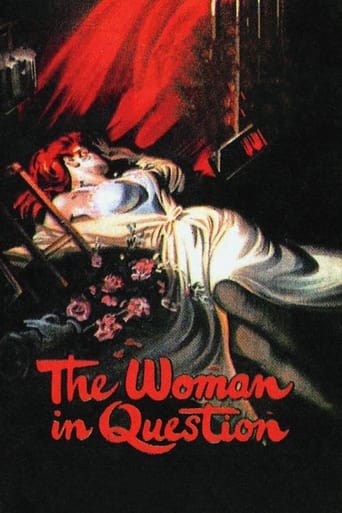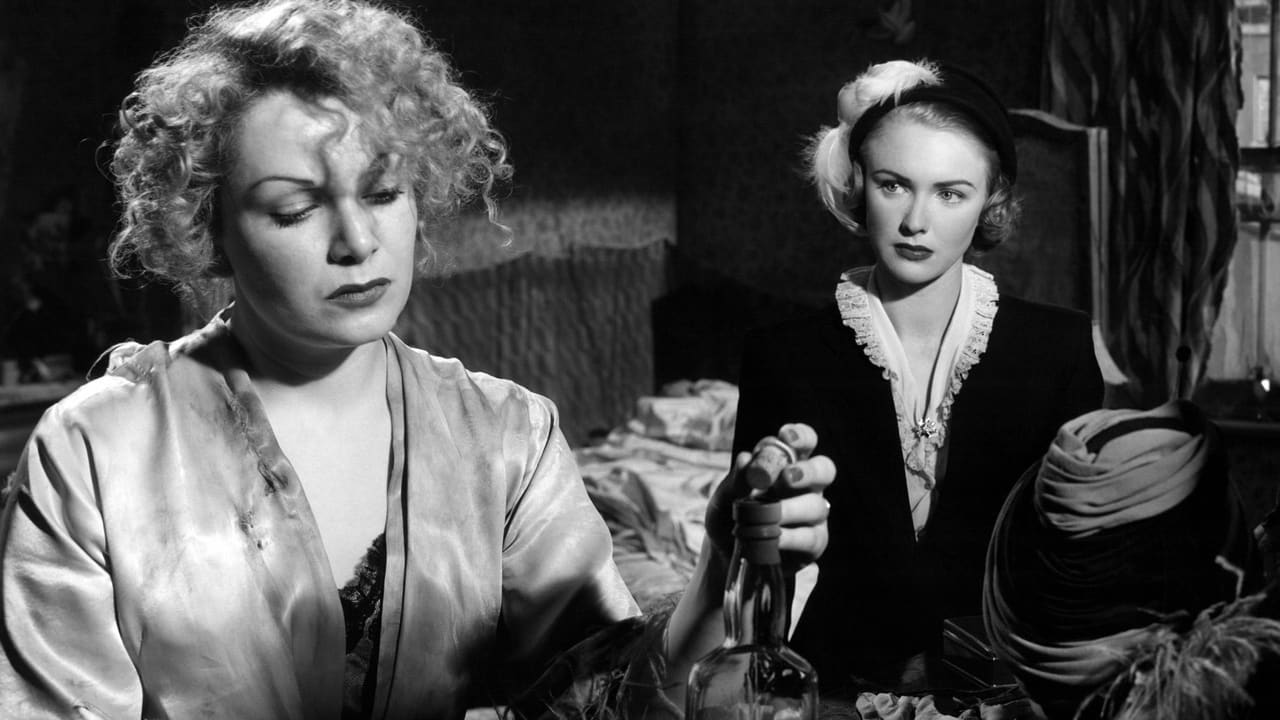TheLittleSongbird
'The Woman in Question's' potential was enormous. Love murder mysteries, Anthony Asquith often was a very reliable director and Jean Kent, Dirk Bogarde and Hermione Baddeley have all been great in other films.After seeing it, 'The Woman in Question' is solid and has some inventive elements. It mostly lives up to its potential but doesn't entirely, there are a few short-comings that bring it down from a potentially great film to just a good one worthy still of more credit. 'The Woman in Question' doesn't get into high gear straight away, it's a little too slow to begin with. Was also one of those people who found the ending abrupt, though the solution was clever and unexpected still.Most of the performances are fine, but for my tastes Duncan Macrae is a little pallid and John McCallum much too hammy.However, 'The Woman in Question' is atmospherically produced and shot. Asquith directs with a lot of engagement and command of the material, helped by that it's good stuff to work from, and the film is hauntingly scored without intruding too much.Script is thought-provoking and does a wonderful job with the development and writing of the titular character, a complex and juicy one. The story is not perfect but is mostly tense and suspenseful with some inventive elements, especially in its treatment of the titular character and what we find out about her.With the exception of two, the performances are very good. The best of the lot is Jean Kent, who is also the best thing about the film and is simply incredible with some of the widest range of emotions ever seen on film. Dirk Bogarde is charismatic in an early role and his accent, which was a good attempt to stretch his acting chops, wasn't an issue to me.In support, Hermione Baddeley in particular has a ball and Charles Victor has some fine moments, especially in the final third.Overall, good and solid film that could have been more. 7/10 Bethany Cox
MartinHafer
Both "Five Angles on Murder" and the Kurosawa film "Rashomon" came out the same year, so it's very possible that neither film influenced the other-- though they sure have a similar style. Both films consist of a mystery and you see the story through different folks' eyes...and they have extremely different views on exactly what ACTUALLY happened. Both are worth seeing, though by many "Rashomon" is considered a classic.When the film begins, a child finds a woman dead in her flat. Apparently she was murdered and the police interrogate several people to try to determine what happened. First is the landlady and her interview seems to dubious value as she seems to let her emotions color what she thinks of everyone. She LOVED the deceased and HATED her friend, Mr. Baker (Dirk Bogarde). When the police talk to the deceased's sister, she sees Baker very differently...as she was in love with him. She also thought her sister was a shrill and vicious woman. And so the movie goes...with the police interviewing different folks and all having a very different view of the dead woman as well as their opinions about who was responsible for her fate. Of all the folks in the film, Jean Kent really stands out as the victim. This is because she had to play such a different character depending on the viewpoint of the interviewee...ranging from almost sickly sweet and refined to coarse and god-awful! It takes talent to have such range! While I would never say the film is as good as the Kurosawa film, it IS very good and very well made...far better than most British pictures of the era.
sol
***SPOILERS*** Clever Rashomon-like British film involving fortune-teller Madam Aster who was found strangled in her flat in an obvious crime of passion by someone she may not have been that passionate with.With policemen Supt. Lodge and his partner Inspt. Butler called on the scene they check out all the clues to Madam Aster's murder and come up with five suspects. As the movie goes on we get statements, and flashbacks, from the five suspects in Madam Aster's murder that all contradict each other. It becomes very apparent to both Lodge & Butler that Madam Aster had deeply offended everyone of the five persons suspected of murdering her. The trick is who of those that she offended was driven to the point of killing her! There's Madam Aster's landlady, and suspect #1, Mrs Finch who didn't like the company that she kept in her apartment that included, suspect# 2, double-talking BS artist and carnival mind reader Bob Baker. It was Baker who left Madam Aster for her far more attractive sister, and suspect #3, Catherine Taylor after she threw him out of her apartment! We, as well as Supt. Lodge & Inspt. Butler, can't leave out the kindly neighborhood "Mr. Fix It All", and suspect #4, Albert Pollard. The meek and always available Pollard was always trying to get the much younger Madam Aster to fall for him and, with both Pollard and Madam Aster still married, become his sex slave or live-in lover. All that the frustrated Pollard ever got from her, for his noble and unselfish services, was nothing more then a handshake smile and thank you!And finally we come to the insanely jealous rummy and bar-room brawler, as well as suspect #5, Sailor Mike Murray who wherever he went violence always followed. Sailor Mike went nuts when he showed up unexpectedly at Madam Aster's apartment, after being out at sea for three months, and finding her with an other man! Throwing Madam Aster's boyfriend, or possible John, down a fight of stairs a fired up Sailor Mike then checked out and got himself juiced up in a local ginmill. With Sailor Mike coming on the scene after Madam Aster's body was discovered by the police was that his way to show that he was innocent of murdering her or him just playing ignorant in order to throw the police off his tail! ***SPOILERS*** It's Supt Lodge who finally cracks the case not by having the evidence lead him to Madam Aster's murderer but the murderer him or herself unknowingly doing the job for him!
lfisher0264
This film repays several viewings. It's not just Astra who changes according to who's telling her story. People's memories of themselves are also flattering. Astra's sister Katie as remembered by Mrs Finch is a nasal-voiced slut. As remembered by herself she is as gracious as a member of the royal family. When we see her with the police (and this we assume is "reality"), she is much nicer than Mrs Finch's view of her, but more lower-class than her own self- image. In the minds of Mrs Finch and Mr Pollard, Astra is always seen in a shaft of light, her voice is like an angel's - and her dressing gown is clean. Katie has the unkindest view of Astra - seeing her as a round-shouldered slattern with a growing out perm, a filthy dressing gown, someone who sleeps in her makeup and (ripped) stockings. Though it's pretty clear that Astra supplements her fortune telling with prostitution, Katie - who is pleasant enough to have Bob fall in love with her - seems to be exaggerating Astra's vulgarity. But at the very end, when the Inspector tells Pollard "This is what really happened" we see... Astra herself, not seen through the distorting lens of another character. And she is the hunched, harsh-voiced woman in the dirty dressing gown.Apart from the unusual psychological detective story (who killed her? who was she?) this film is great for the background of the little seaside town, the shabby fairground, the little houses unchanged for 50 years.


 AD
AD


